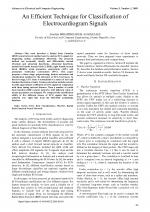| 3/2009 - 16 |
An Efficient Technique for Classification of Electrocardiogram SignalsEBRAHIMZADEH, A. |
| Extra paper information in |
| Click to see author's profile in |
| Download PDF |
Author keywords
ECG beat classification, wavelet, radial basis function neural network
References keywords
classification(4)
Blue keywords are present in both the references section and the paper title.
About this article
Date of Publication: 2009-10-26
Volume 9, Issue 3, Year 2009, On page(s): 89 - 93
ISSN: 1582-7445, e-ISSN: 1844-7600
Digital Object Identifier: 10.4316/AECE.2009.03016
Web of Science Accession Number: 000271872000016
SCOPUS ID: 77954728832
Abstract
This work describes a Radial Basis Function (RBF) neural network method used to analyze ECG signals for diagnosing cardiac arrhythmias effectively. The proposed method can accurately classify and differentiate normal (Normal) and abnormal heartbeats. Abnormal heartbeats include left bundle branch block (LBBB), right bundle branch block (RBBB), atrial premature contractions (APC) and premature ventricular contractions (PVC). This paper proposes a three stage, preprocessing, feature extraction and classification method for the detection of ECG beat types. In the first stage, ECG beats is normalized to a mean of zero and standard deviation of unity. Feature extraction module extracts wavelet approximate coefficients of ECG signals in conjunction with three timing interval features. Then a number of radial basis function (RBF) neural networks with different value of spread parameter are designed. We compared the classification ability of five different classes of ECG signals that were achieved over eight files from the MIT/BIH arrhythmia database. |
| References | | | Cited By «-- Click to see who has cited this paper |
| [1] Hu, G. M., S. Palreddy, and W., Tompkins, "Patient Adaptable ECG Beat Classifier Using a Mixture of Experts Approach", IEEE Trans. Biomed. Eng., Vol. 44, 1997, pp. 891-900 [CrossRef] [PubMed] [SCOPUS Times Cited 529] [2] T.H. Yeap, F. Johnson, M. Rachniowski, "ECG Beat Classification by a Neural Network", Proceedings Annual International Conference of the IEEE EMBS Society pg 1457-1458, 1990 [3] O. T. Inan, L. Giovangrandi, and G. T. A. Kovacs., "Robust Neural-Network-Based Classification of Premature Ventricular Contractions Using Wavelet Transform and Timing Interval Features", IEEE Trans. Biomed. Eng., vol. 53, no. 12, pp. 2507-2515, Dec. 2006 [CrossRef] [PubMed] [Web of Science Times Cited 251] [SCOPUS Times Cited 357] [4] S. N. Yu, and K. T. Chou., "Selection of significant for ECG beat classification", Expert Systems with Applications, Vol. 36, pp. 2088-2096, 2009 [CrossRef] [Web of Science Times Cited 82] [SCOPUS Times Cited 106] [5] Chazal P., O'Dwyer M., Reilly R.B., "Automatic classification of heartbeats using ECG morphology and heartbeat interval features", IEEE Trans Biomed Eng 2004; 51:1196-1206 [CrossRef] [Web of Science Times Cited 1052] [SCOPUS Times Cited 1388] [6] G. D. Clifford, F. Azuaje, P. E. McShary, "Advanced Methods and Tools for ECG Data Analysis", Artech House: Norwood, MA 02062, 2006 [7] R. Mark and G. Moody, "MIT-BIH Arrhythmia Database 1997", http://ecg.mit.edu/dbinfo.html [8] G. B. Moody and R. G. Mark, "The impact of the mit/bih arrhythmia database", IEEE Eng. Med. Biol. Mag., vol. 20, no. 3, May-Jun, 2001 [PubMed] [9] Amara Graps, "An Introduction to Wavelets", IEEE Comp. Sc. And Eng., Vol. 2, No. 2, 1995 [CrossRef] [Web of Science Times Cited 923] [SCOPUS Times Cited 1360] Web of Science® Citations for all references: 2,308 TCR SCOPUS® Citations for all references: 3,740 TCR Web of Science® Average Citations per reference: 256 ACR SCOPUS® Average Citations per reference: 416 ACR TCR = Total Citations for References / ACR = Average Citations per Reference We introduced in 2010 - for the first time in scientific publishing, the term "References Weight", as a quantitative indication of the quality ... Read more Citations for references updated on 2025-06-01 05:12 in 36 seconds. Note1: Web of Science® is a registered trademark of Clarivate Analytics. Note2: SCOPUS® is a registered trademark of Elsevier B.V. Disclaimer: All queries to the respective databases were made by using the DOI record of every reference (where available). Due to technical problems beyond our control, the information is not always accurate. Please use the CrossRef link to visit the respective publisher site. |
Faculty of Electrical Engineering and Computer Science
Stefan cel Mare University of Suceava, Romania
All rights reserved: Advances in Electrical and Computer Engineering is a registered trademark of the Stefan cel Mare University of Suceava. No part of this publication may be reproduced, stored in a retrieval system, photocopied, recorded or archived, without the written permission from the Editor. When authors submit their papers for publication, they agree that the copyright for their article be transferred to the Faculty of Electrical Engineering and Computer Science, Stefan cel Mare University of Suceava, Romania, if and only if the articles are accepted for publication. The copyright covers the exclusive rights to reproduce and distribute the article, including reprints and translations.
Permission for other use: The copyright owner's consent does not extend to copying for general distribution, for promotion, for creating new works, or for resale. Specific written permission must be obtained from the Editor for such copying. Direct linking to files hosted on this website is strictly prohibited.
Disclaimer: Whilst every effort is made by the publishers and editorial board to see that no inaccurate or misleading data, opinions or statements appear in this journal, they wish to make it clear that all information and opinions formulated in the articles, as well as linguistic accuracy, are the sole responsibility of the author.



